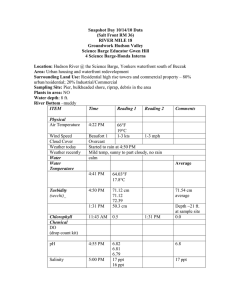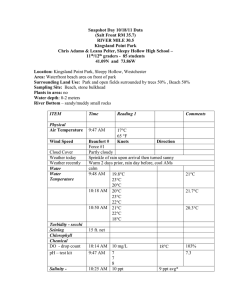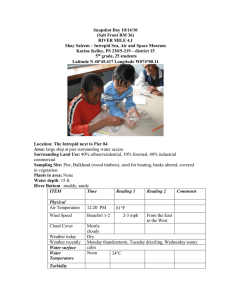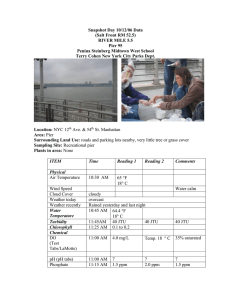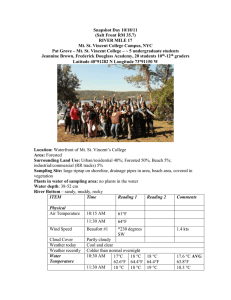How Much Is A Part Per Million?
advertisement
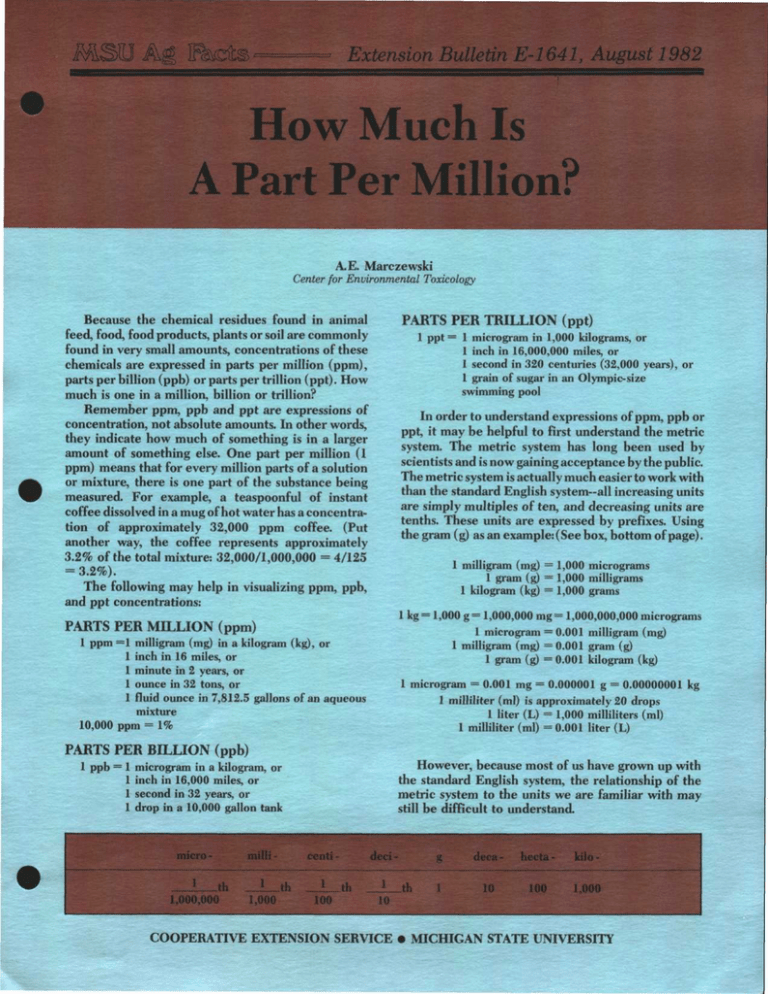
Extension Bulletin E-1641, August 1982 How Much Is A Part Per Million? A.E. Marczewski Center for Environmental Toxicology Because the chemical residues found in animal feed, food, food products, plants or soil are commonly found in very small amounts, concentrations of these chemicals are expressed in parts per million (ppm), parts per billion (ppb) or parts per trillion (ppt). How much is one in a million, billion or trillion? Remember ppm, ppb and ppt are expressions of concentration, not absolute amounts. In other words, they indicate how much of something is in a larger amount of something else. One part per million (1 ppm) means that for every million parts of a solution or mixture, there is one part of the substance being measured. For example, a teaspoonful of instant coffee dissolved in a mug of hot water has a concentration of approximately 32,000 ppm coffee. (Put another way, the coffee represents approximately 3.2% of the total mixture: 32,000/1,000,000 = 4/125 = 3.2%). The following may help in visualizing ppm, ppb, and ppt concentrations: PARTS PER TRILLION (ppt) 1 ppt = 1 microgram in 1,000 kilograms, or 1 inch in 16,000,000 miles, or 1 second in 320 centuries (32,000 years), or 1 grain of sugar in an Olympic-size swimming pool In order to understand expressions of ppm, ppb or ppt, it may be helpful to first understand the metric system. The metric system has long been used by scientists and is now gaining acceptance by the public. The metric system is actually much easier to work with than the standard English system—all increasing units are simply multiples of ten, and decreasing units are tenths. These units are expressed by prefixes. Using the gram (g) as an example: (See box, bottom of page). 1 milligram (mg) = 1,000 micrograms 1 gram (g) = 1,000 milligrams 1 kilogram (kg) = 1,000 grams 1 kg - 1,000 g = 1,000,000 mg= 1,000,000,000 micrograms 1 microgram = 0.001 milligram (mg) 1 milligram (mg) = 0.001 gram (g) 1 gram (g) = 0.001 kilogram (kg) PARTS PER MILLION (ppm) 1 ppm =1 1 1 1 1 milligram (mg) in a kilogram (kg), or inch in 16 miles, or minute in 2 years, or ounce in 32 tons, or fluid ounce in 7,812.5 gallons of an aqueous mixture 10,000 ppm = 1% 1 microgram = 0.001 mg = 0.000001 g = 0.00000001 kg 1 milliliter (ml) is approximately 20 drops 1 liter (L) = 1,000 milliliters (ml) 1 milliliter (ml) = 0.001 liter (L) PARTS PER BILLION (ppb) However, because most of us have grown up with the standard English system, the relationship of the metric system to the units we are familiar with may still be difficult to understand. 1 ppb = 1 microgram in a kilogram, or 1 inch in 16,000 miles, or 1 second in 32 years, or 1 drop in a 10,000 gallon tank milli- \ th 1,000,000 centi- _i_th _J_th 1,000 100 deci- g deca- hecta- kilo- 10 100 1,000 COOPERATIVE EXTENSION SERVICE • MICHIGAN STATE UNIVERSITY There are 28.35 grams in one ounce. There are 454 grams in one pound. 1 g = 0.035 ounces 1 kg = 2.2 pounds For liquid measures, 1 teaspoon = 5 milliliters (ml) 1 Tablespoon = 15 ml 1 cup = 236 ml 1 pint = 2 cups = 472 ml 1 quart •* 2 pints = 946 ml One liter (L) = 0.26 gallons = 1.06 quarts = 2.11 pints = 4.2 cups of micrograms of chemical present in each gram of soil mixture. ppm = 1 microgram in a gram = 1 milligram in a kilogram Table 1 shows how to convert various measures between the English and metric systems. The metric system is convenient to use with expressions of ppm, ppb, and ppt. For dry matter mixtures, such as herbicide mixed with soil, ppm is equal to the number Regardless of what is being measured and how that measurement is being expressed, ppm, ppb and ppt are always expressions of concentration—what amount of something is in a million, billion or trillion of something else. Parts per million in an aqueous solution is equal to the number of milligrams of chemical present in each liter of solution. ppm = mg chemical in liter of solution = microgram of chemical in milliliter of solution. Table 1. Approximate conversions — metric and English systems. You can find — If you multiply — by— Length You can find — If you multiply — by- ounces pounds short tons 28.35 0.4536 0.9072 Mass millimeters centimeters meters kilometers inches inches yards miles feet Area square centimeters square meters square meters square kilometers square hectometers (hectares) square inches square yards square miles acres inches feet yards miles millimeters centimeters meters kilometers meters square square square square acres 25.4 30.48 0.914 1.609 0.03937 0.3937 1.094 0.6214 3.28 inches feet yards miles 6.452 0.093 0.836 2.589 0.404 square centimeters square meters square kilometers square hectometers (hectares) 0.1550 1.196 0.347 2.471 (1 short ton = 2,000 pounds; 1 metric ton = 2,204 622 pounds) grams kilograms megagrams (metric tons) ounces pounds short tons Liquid Volume milliliters liters liters liters ounces pints quarts gallons (U.S.) U.S. liquid measure Temperature degrees Celsius (centigrade) degrees Fahrenheit grams kilograms megagrams (metric tons) ounces pints quarts gallons (U.S.) milliliters liters liters liters Imperial liquid measure 0.0353 2.2046 1.102 29.573 0.473 0.946 3.785 0.0338 2.11 1.057 0.2642 0.8327 degrees Fahrenheit 5/9 (after subtracting 32) degrees Celsius 9/5 (then (centigrade) add 32) From: Wood, Anderson and Powell. 1977. Weed Science: Principles. MICHIGAN STATE UNIVERSITY COOPERATIVE EXTENSION SERVICE MSU is an Affirmative Action / Equal Opportunity Institution. Cooperative Extension Service programs are open to all without regard to race, color, national origin, or sex. Issued in furtherance of cooperative extension work in agriculture and home economics, acts of May 8, and June 30, 1914, in cooperation with the U.S. Department of Agriculture. Gordon E. Guyer, Director, Cooperative Extension Service, Michigan State University, E. Lansing, Ml 48824. This information is for educational purposes only. Reference to commercial products or trade names does not imply endorsement by the Cooperative Extension Service or bias against those hot mentioned. This bulletin becomes public property upon publication and may be reprinted verbatim as a separate or within another publication with credit to MSU. Reprinting cannot be used to endcse or advertise a commercial product or company. 1P-7.5M-8.82 KMF-KE, Price 15t, Single Copy Free to Michigan Residents.
